Summer Season Vegetables in India: A Guide to Thriving Crops and Smart Cultivation
“In India, different vegetables are grown according to each season, but do you know which vegetables are most beneficial in summer?” ☀🌿
According to agricultural experts and ICAR research, vegetables grown in India in summer are good for health and a good option for farming and agri-business. ☘
🌍 According to FAO (Food and Agriculture Organization) data, the demand for summer vegetables in India increases by 15-20% every year, as they are ideal for hydration, immunity boosting and easy cultivation. 🥗💦
🔎 Agriculture experts say that some vegetables like bhindi, kheera, and ghiya give good yield even with less water in summers, which can become a profitable model for small farming and organic farming.
🥗 Why is this blog useful for you?
✅ Top 10 Summer Vegetables which are best for farming and health both
✅ Farming tips of ICAR & Agri-Experts which increase the productivity of these vegetables
✅ Market Trends & Profit Analysis – Scope of summer vegetables for Agri-business
If you also want expert-backed information that helps in your farming or kitchen gardening, this blog is a complete guide! 🚀✅
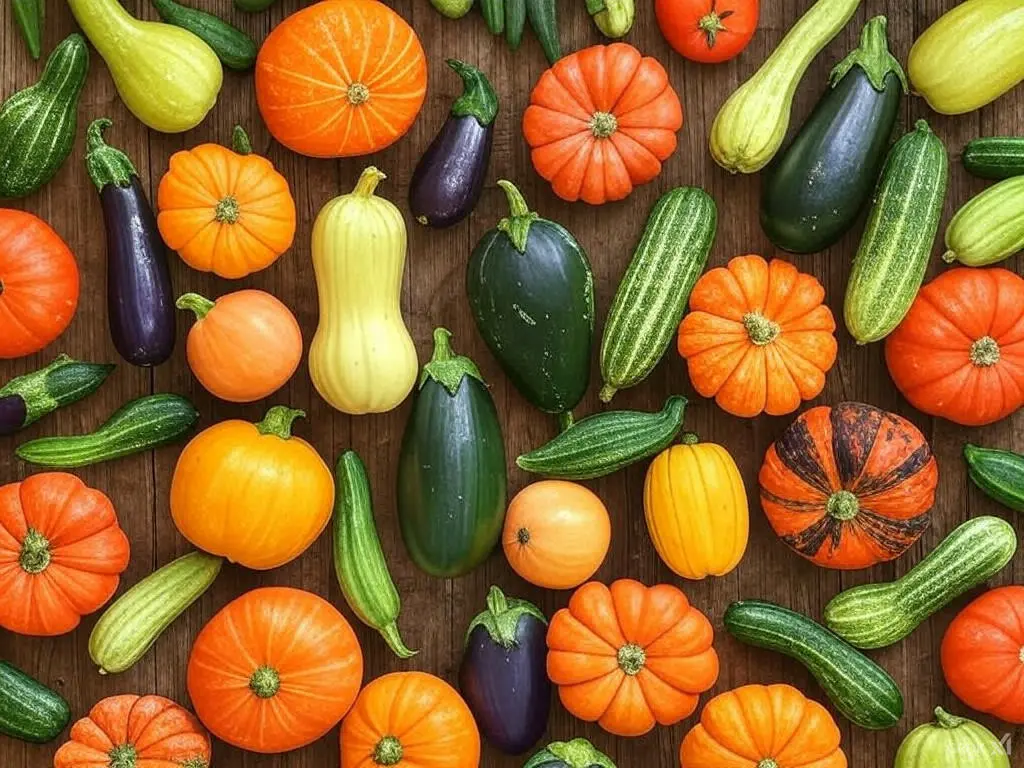
🥒 Top 10 Summer Season Vegetables in India
Here’s a detailed table of the Top 10 Summer Season Vegetables in India, including their common names, botanical names, family, and chromosome numbers.
Common Name | Botanical Name | Family | Chromosome Number (2n) |
1. Cucumber | Cucumis sativus | Cucurbitaceae | 14 |
2. Bottle Gourd | Lagenaria siceraria | Cucurbitaceae | 22 |
3. Okra | Abelmoschus esculentus | Malvaceae | 130 |
4. Bitter Gourd | Momordica charantia | Cucurbitaceae | 22 |
5. Pumpkin | Cucurbita moschata | Cucurbitaceae | 40 |
6. Spinach | Spinacia oleracea | Amaranthaceae | 12 |
7. Eggplant | Solanum melongena | Solanaceae | 24 |
8. Amaranth | Amaranthus spp. | Amaranthaceae | 32 |
9. Snake Gourd | Trichosanthes cucumerina | Cucurbitaceae | 22 |
10. Watermelon | Citrullus lanatus | Cucurbitaceae | 22 |
Summer Season Vegetables in India have some features like…
Cucurbitaceae Family Dominance: Most summer vegetables like cucumber, bottle gourd, bitter gourd, pumpkin, and watermelon belong to the Cucurbitaceae family, known for their high water content and heat tolerance.
Chromosome Numbers: Chromosome numbers vary widely, with okra having the highest (2n=130) and spinach the lowest (2n=12).
Nutritional Powerhouses: These vegetables are not only heat-resistant but also packed with vitamins, minerals, and antioxidants, making them ideal for summer consumption.
Best Summer Season Vegetables in India complete Information
Here are the best summer season vegetables in India. Including nutritional importance, how to grow, and recipe ideas, have also been considered.
1. Tomato (Lycopersicon esculentum)
🔬 According to ICAR, tomatoes are one of the most widely grown vegetables in India, producing more than 20 million metric tons. It is a rich source of vitamin C, lycopene and antioxidants, which help boost immunity and maintain hydration in summers.
📈 According to reports of NABARD and APEDA, India exports tons of tomatoes every year to UAE, Bangladesh and Nepal, which makes it a profitable agri-business crop. If you are planning for profitable farming or kitchen gardening, tomatoes can be one of the best options! 🌱✅
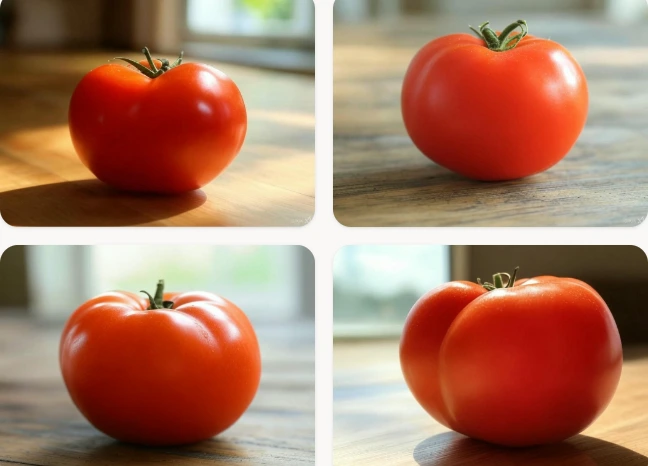
Nutritional Importance of Tomatoes-
Nutrient | Amount per 100g | Health Benefits |
Calories | 18 kcal | Low-calorie food, ideal for weight management. |
Water | 95% | Keeps the body hydrated and cool during summer. |
Protein | 0.9 g | Supports muscle repair and growth. |
Carbohydrates | 3.9 g | Provides quick energy. |
Fiber | 1.2 g | Aids digestion and promotes gut health. |
Vitamin C | 14 mg | Boosts immunity, promotes skin health, |
Vitamin A | 42 µg | Supports eye health and improves vision. |
Vitamin K | 7.9 µg | Essential for blood clotting and bone health. |
Potassium | 237 mg | Regulates blood pressure and supports heart health. |
Lycopene | 2573 µg | Powerful antioxidant that protects against sun damage |
How to Grow Tomatoes in India: A Step-by-Step Guide-
1. Choose the Right Variety
Popular Varieties: Pusa Ruby, Arka Vikas, Sonali, and Hybrid Tomatoes.
Season: Summer (February–March) is the ideal time for planting.
2. Prepare the Soil
Soil Type: Well-drained, loamy soil with a pH of 6–7.
Soil Prep: Mix compost or organic manure for better fertility.
3. Planting
Seeds or Seedlings: Start with seeds in nursery trays or buy seedlings from a local nursery.
Spacing: Plant seedlings 2–3 feet apart to allow growth.
4. Watering
Frequency: Water deeply once every 2–3 days. Avoid overwatering to prevent root rot.
Tip: Use drip irrigation for consistent moisture.
5. Sunlight and Temperature
Sunlight: Tomatoes need 6–8 hours of direct sunlight daily.
Temperature: Ideal range is 20–30°C.
6. Pest Control
Common Pests: Aphids, whiteflies, and fruit borers.
Organic Solutions: Use neem oil or garlic spray to deter pests.
7. Harvesting
Time: Tomatoes are ready to harvest in 60–90 days.
Signs: Look for firm, bright red fruits.
Tomato Recipe Ideas: From Classic to Creative-

Here are some easy and delicious recipes to try:
1. Classic Tomato Curry
Ingredients: Tomatoes, onions, garlic, ginger, spices (turmeric, cumin, coriander).
Steps: Sauté onions, add spices, and cook tomatoes until soft. Serve with rice or roti.
2. Tomato Basil Salad
Ingredients: Cherry tomatoes, fresh basil, olive oil, balsamic vinegar, salt, and pepper.
Steps: Toss all ingredients together for a refreshing summer salad.
3. Tomato Chutney
Ingredients: Tomatoes, red chillies, garlic, tamarind, and jaggery.
Steps: Blend all ingredients and temper with mustard seeds and curry leaves.
4. Stuffed Tomatoes
Ingredients: Large tomatoes, paneer, spices, and herbs.
Steps: Hollow out tomatoes, stuff with spiced paneer, and bake until tender.
5. Tomato Soup
Ingredients: Tomatoes, onions, garlic, vegetable stock, and cream.
Steps: Cook tomatoes with onions and garlic, blend, and add cream for a creamy texture.
2. Okra/Lady’s Finger (Abelmoschus esculentus)
According to ICAR, Okra (Bhindi) is a major summer vegetable in India, which is rich in fiber, folate and vitamins C & K. It helps in boosting digestive health and immunity. 🌱
📈 According to NABARD reports, India produces more than 6 million metric tons of bhindi every year, in which Maharashtra, Andhra Pradesh and Karnataka are the top producers. High-yield varieties like Arka Anamika and Pusa are best for Bhindi farming. 🚜💰
✅ If you are planning profitable summer farming or kitchen gardening, then bhindi is a great option!
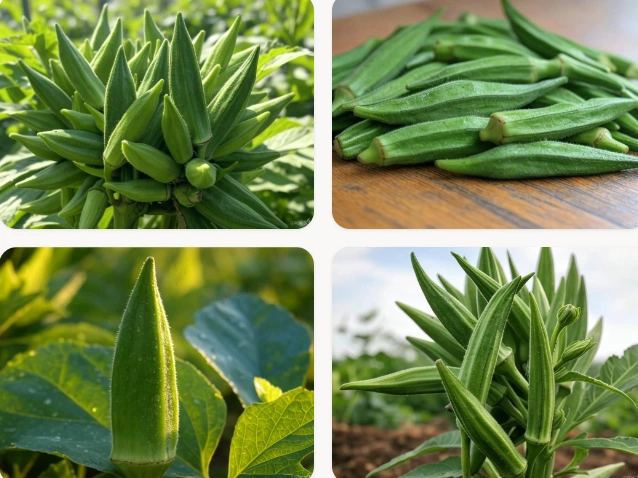
Nutritional Importance of Okra-
Nutrient | Amount per 100g | Health Benefits |
Calories | 33 kcal | Low-calorie food, ideal for weight management. |
Water | 90% | Keeps the body hydrated and cool during summer. |
Protein | 2 g | Supports muscle repair and growth. |
Carbohydrates | 7 g | Provides quick energy. |
Fiber | 3.2 g | Aids digestion and promotes gut health. |
Vitamin C | 23 mg | Boosts immunity, promotes skin health |
Vitamin A | 36 µg | Supports eye health and improves vision. |
How to Grow Okra in India: A Step-by-Step Guide-
Okra is relatively easy to grow, even for beginners. Here’s how you can cultivate it in your backyard or balcony:
1. Choose the Right Variety
Popular Varieties: Pusa Sawani, Arka Anamika, and Parbhani Kranti.
Season: Summer (February–March) is the ideal time for planting.
2. Prepare the Soil
Soil Type: Well-drained, loamy soil with a pH of 6–7.
Soil Prep: Mix compost or organic manure for better fertility.
3. Planting
Seeds or Seedlings: Start with seeds soaked overnight for better germination.
Spacing: Plant seeds 1–2 feet apart to allow growth.
4. Watering
Frequency: Water deeply once every 3–4 days. Avoid overwatering to prevent root rot.
Tip: Use drip irrigation for consistent moisture.
5. Sunlight and Temperature
Sunlight: Okra needs 6–8 hours of direct sunlight daily.
Temperature: Ideal range is 25–35°C.
6. Pest Control
Common Pests: Aphids, whiteflies, and fruit borers.
Organic Solutions: Use neem oil or garlic spray to deter pests.
7. Harvesting
Time: Okra is ready to harvest in 50–60 days.
Signs: Pick pods when they are 2–3 inches long and tender.
🍲 Okra Recipe Ideas: From Classic to Creative-
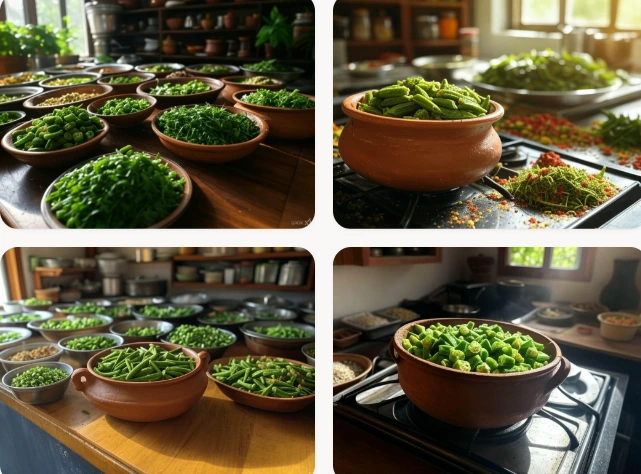
Here are some easy and delicious recipes to try:
1. Bhindi Masala
Ingredients: Okra, onions, tomatoes, spices (turmeric, cumin, coriander).
Steps: Sauté okra until crispy, add spices, and cook with onions and tomatoes. Serve with roti.
2. Crispy Okra Fries
Ingredients: Okra, besan (gram flour), spices, and oil for frying.
Steps: Coat okra slices with spiced besan and fry until crispy.
3. Okra Curry
Ingredients: Okra, coconut milk, curry leaves, and spices.
Steps: Cook okra in a coconut-based gravy for a South Indian twist.
4. Stuffed Okra
Ingredients: Large okra, besan, spices, and herbs.
Steps: Slit okra, stuff with spiced besan, and shallow fry until tender.
5. Okra Salad
Ingredients: Okra, cherry tomatoes, olive oil, lemon juice, and herbs.
Steps: Blanch okra, toss with other ingredients and serve chilled.
3. 🥒 Bitter Gourd (Momordica charantia)
Bitter gourd, also known as Karela, is a unique summer Season vegetables in India.
According to ICAR, Bitter Gourd (Karela) is a medicinal vegetable for summers, which is rich in antioxidants, vitamin C and charantin. It helps to control diabetes, boost immunity and improve digestion. 🌱
📈 According to NABARD reports, India produces more than 1.2 million metric tons of bitter gourd every year, of which Uttar Pradesh, Bihar and West Bengal are the top producers. High-yield varieties like Pusa Vishesh and Arka Harit are best for farming. 🚜💰
✅ If you are planning medicinal farming or organic vegetable cultivation, then bitter gourd is a profitable option!
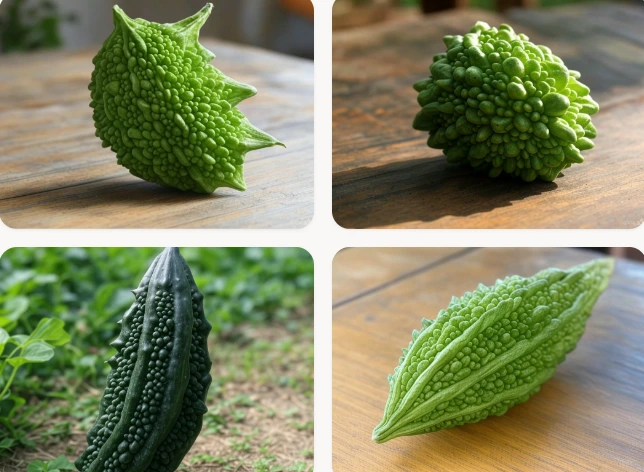
Nutritional Importance of Bitter Gourd-
Nutrient | Amount per 100g | Health Benefits |
Calories | 17 kcal | Low-calorie food, ideal for weight management. |
Water | 94% | Keeps the body hydrated and cool during summer. |
Protein | 1 g | Supports muscle repair and growth. |
Carbohydrates | 3.7 g | Provides quick energy. |
Fiber | 2.8 g | Aids digestion and promotes gut health. |
Vitamin C | 84 mg | Acts as an antioxidant. |
Calcium | 19 mg | Supports muscle and nerve function. |
Magnesium | 17 mg | Strengthens bones and teeth. |
🌱 How to Grow Bitter Gourd in India: A Step-by-Step Guide-
1. Choose the Right Variety
Popular Varieties: Pusa Hybrid, Arka Harit, and Priya.
Season: Summer (February–March) is the ideal time for planting.
2. Prepare the Soil
Soil Type: Well-drained, loamy soil with a pH of 6–7.
Soil Prep: Mix compost or organic manure for better fertility.
3. Planting
Seeds or Seedlings: Start with seeds soaked overnight for better germination.
Spacing: Plant seeds 1–2 feet apart to allow growth.
4. Watering
Frequency: Water deeply once every 3–4 days. Avoid overwatering to prevent root rot.
Tip: Use drip irrigation for consistent moisture.
5. Sunlight and Temperature
Sunlight: Bitter gourd needs 6–8 hours of direct sunlight daily.
Temperature: Ideal range is 25–35°C.
6. Pest Control
Common Pests: Aphids, fruit flies, and spider mites.
Organic Solutions: Use neem oil or garlic spray to deter pests.
7. Harvesting
Time: Bitter gourd is ready to harvest in 55–60 days.
Signs: Pick fruits when they are 4–6 inches long and firm.
🍲 Bitter Gourd Recipe Ideas: From Classic to Creative-
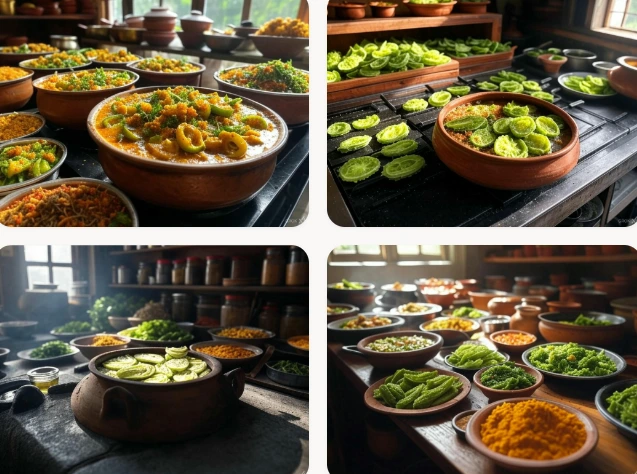
Here are some easy and delicious recipes to try:
1. Stuffed Bitter Gourd (Bharwa Karela)
Ingredients: Bitter gourd, onions, spices (turmeric, cumin, coriander), and jaggery.
Steps: Slit bitter gourd, stuff with spiced onion mixture, and cook until tender.
2. Bitter Gourd Chips
Ingredients: Bitter gourd, besan (gram flour), spices, and oil for frying.
Steps: Slice bitter gourd thinly, coat with spiced besan, and fry until crispy.
3. Bitter Gourd Curry
Ingredients: Bitter gourd, coconut milk, curry leaves, and spices.
Steps: Cook bitter gourd in a coconut-based gravy for a South Indian twist.
4. Bitter Gourd Juice
Ingredients: Bitter gourd, lemon juice, honey, and water.
Steps: Blend bitter gourd with water, strain, and add lemon juice and honey for taste.
5. Bitter Gourd Stir-Fry
Ingredients: Bitter gourd, onions, garlic, and spices.
Steps: Sauté bitter gourd with onions and garlic until crispy.
4. 🥒 Cucumber (Cucumis sativus)
According to ICAR, Cucumber (Kheera) is an essential vegetable for summers, which is rich in 96% water content, vitamins and antioxidants. It helps in hydrating the body, detoxification and improving digestion. 🌱
📈 According to the reports of NHB (National Horticulture Board), more than 1.5 million metric tons of Kheera is produced in India every year, in which Madhya Pradesh, Uttar Pradesh and Karnataka are the top producers. High-yield varieties like Pusa Uday and Malini are best for farming. 🚜
✅ If you are planning summer farming or organic gardening, then Kheera is a fast-growing and profitable option!
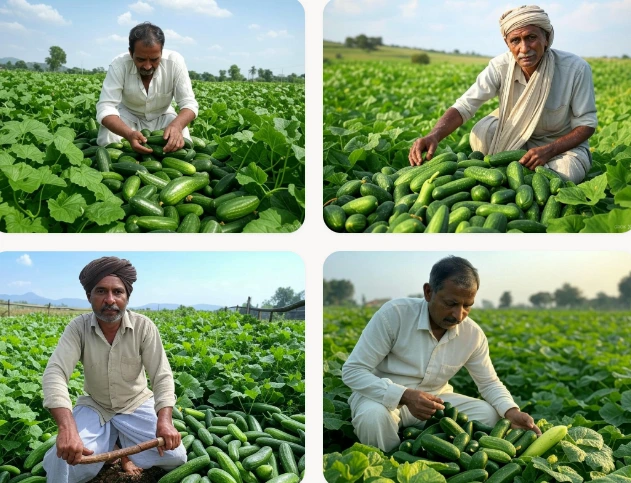
Nutritional Importance of Cucumber-
Nutrient | Amount per 100g | Health Benefits |
Water | 96% | Keeps the body hydrated and aids in detoxification. |
Calories | 15 kcal | Low in calories, making it ideal for weight management. |
Carbohydrates | 3.6 g | Provides a small amount of energy. |
Fiber | 0.5 g | Supports digestion and prevents constipation. |
Protein | 0.7 g | Helps in tissue repair and muscle maintenance. |
Fat | 0.1 g | Negligible fat content, making it heart-friendly. |
🌱 How to Grow Cucumber in India-
Here’s how you can cultivate it in your backyard or balcony:
1. Choose the Right Variety
Popular Varieties: Poinsett, Straight Eight, and Japanese Long.
Season: Summer (February–March) is the ideal time for planting.
2. Prepare the Soil
Soil Type: Well-drained, loamy soil with a pH of 6–7.
Soil Prep: Mix compost or organic manure for better fertility.
3. Planting
Seeds or Seedlings: Start with seeds soaked overnight for better germination.
Spacing: Plant seeds 1–2 feet apart to allow growth.
4. Watering
Frequency: Water deeply once every 2–3 days. Avoid overwatering to prevent root rot.
Tip: Use drip irrigation for consistent moisture.
5. Sunlight and Temperature
Sunlight: Cucumber needs 6–8 hours of direct sunlight daily.
Temperature: Ideal range is 20–30°C.
6. Pest Control
Common Pests: Aphids, cucumber beetles, and spider mites.
Organic Solutions: Use neem oil or garlic spray to deter pests.
7. Harvesting
Time: Cucumber is ready to harvest in 50–60 days.
Signs: Pick fruits when they are 6–8 inches long and firm.
🍲 Cucumber Recipe Ideas: From Classic to Creative-
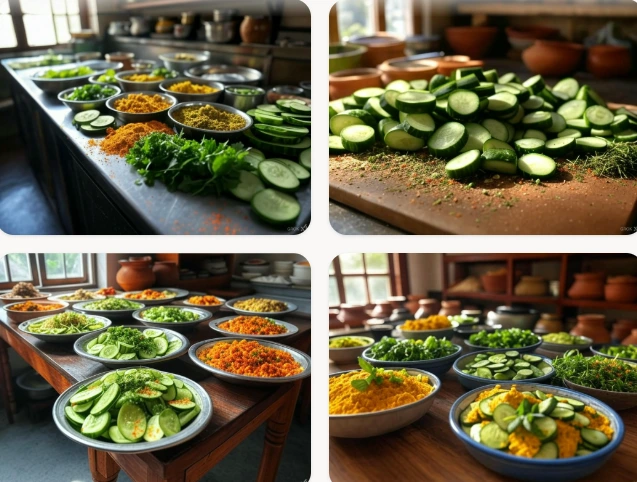
Here are some easy and delicious recipes to try:
1. Cucumber Raita
Ingredients: Cucumber, yogurt, mint, roasted cumin powder.
Steps: Grate cucumber, mix with yogurt and add spices. Chill and serve!
2. Cucumber Salad
Ingredients: Cucumber, cherry tomatoes, olive oil, lemon juice, and herbs.
Steps: Toss all ingredients together for a refreshing summer salad.
3. Cucumber Sandwich
Ingredients: Cucumber, bread, cream cheese, and herbs.
Steps: Spread cream cheese on bread, add cucumber slices, and sprinkle with herbs.
4. Cucumber Juice
Ingredients: Cucumber, mint, lemon juice, and honey.
Steps: Blend cucumber with water, strain, and add lemon juice and honey for taste.
5. Cucumber Soup
Ingredients: Cucumber, yogurt, garlic, and herbs.
Steps: Blend cucumber with yogurt and garlic, chill, and serve as a cold soup.
5.🍆 Brinjal (Baingan)(Solanum melongena)
Brinjal is the best summer season vegetables in India, also known as Eggplant or Aubergine,
According to ICAR, Brinjal (Eggplant) is a healthy and versatile summer vegetable that is rich in fibre, antioxidants, vitamin B6, and potassium. It helps improve digestion, boost heart health and aid in weight management. 🌱
📈 According to NABARD reports, India produces more than 15 million metric tons of eggplant every year, with West Bengal, Uttar Pradesh, and Andhra Pradesh being the biggest producers. High-yield varieties like Arka Nidhi and Pusa Purple Long are best for farming. 🚜💰
✅ If you are planning sustainable farming or kitchen gardening, then mustard can be a profitable and healthy option!
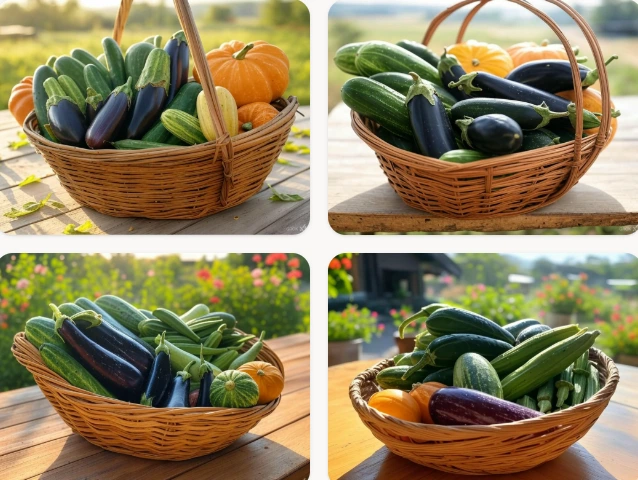
Nutrient | Amount per 100g | Health Benefits |
Calories | 25 kcal | 25 kcal |
Water | 92% | Keeps the body hydrated and cool during summer. |
Protein | 1 g | Supports muscle repair and growth. |
Carbohydrates | 6 g | Provides quick energy. |
Fiber | 3 g | Aids digestion and promotes gut health. |
Vitamin C | 2.2 mg | acts as an antioxidant. |
🌱 How to Grow Brinjal in India: A Step-by-Step Guide-
1. Choose the Right Variety
Popular Varieties: Pusa Purple Long, Arka Keshav, and Hybrid 11.
Season: Summer (February–March) is the ideal time for planting.
2. Prepare the Soil
Soil Type: Well-drained, loamy soil with a pH of 5.5–6.5.
Soil Prep: Mix compost or organic manure for better fertility.
3. Planting
Seeds or Seedlings: Start with seeds soaked overnight for better germination.
Spacing: Plant seeds 1–2 feet apart to allow growth.
4. Watering
Frequency: Water deeply once every 3–4 days. Avoid overwatering to prevent root rot.
Tip: Use drip irrigation for consistent moisture.
5. Sunlight and Temperature
Sunlight: Brinjal needs 6–8 hours of direct sunlight daily.
Temperature: Ideal range is 22–30°C.
6. Pest Control
Common Pests: Aphids, fruit borers, and spider mites.
Organic Solutions: Use neem oil or garlic spray to deter pests.
7. Harvesting
Time: Brinjal is ready to harvest in 70–85 days.
Signs: Pick fruits when they are glossy and firm.
🍲 Brinjal Recipe Ideas: From Classic to Creative-
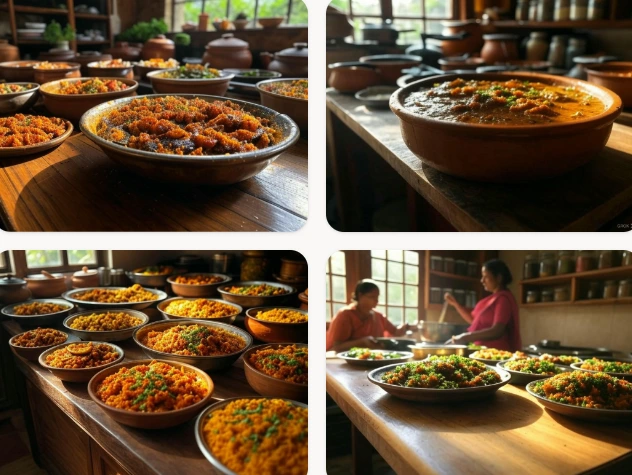
Brinjal is incredibly versatile and can be used in a variety of dishes. Here are some easy and delicious recipes to try:
1. Baingan Bharta
Ingredients: Brinjal, onions, tomatoes, spices (turmeric, cumin, coriander).
Steps: Roast brinjal, mash, and cook with onions and tomatoes. Serve with roti.
2. Stuffed Brinjal (Bharwa Baingan)
Ingredients: Small brinjals, besan (gram flour), spices, and herbs.
Steps: Slit brinjals, stuff with spiced besan, and cook until tender.
3. Brinjal Curry
Ingredients: Brinjal, coconut milk, curry leaves, and spices.
Steps: Cook brinjal in a coconut-based gravy for a South Indian twist.
4. Brinjal Chips
Ingredients: Brinjal, besan (gram flour), spices, and oil for frying.
Steps: Slice brinjal thinly, coat with spiced besan, and fry until crispy.
5. Brinjal Stir-Fry
Ingredients: Brinjal, onions, garlic, and spices.
Steps: Sauté brinjal with onions and garlic until crispy.
Why Matter Summer Season Vegetables in India
Many parts of India can witness mercury levels soaring over 40 degrees Celsius during the summers. While that can be considered cruel, Mother Nature often balances things out in her manner. Summer vegetables in India have high nutritional value and boast high water content to keep you hydrated and healthy.
Also, these veggies tend to do well in hot climatic regions which makes them a staple in Indian households. Must-have vegetables for the summer season include the highly nutritious bitter gourd which is rich in antioxidants and refreshing cucumbers.
Here’s why summer Season vegetables in India are important :
1. Rich in Water Content – Prevents Dehydration
2. Light and Easy to Digest
3. High in Essential Vitamins & Antioxidants
4. Cooling Effect on the Body
5. Boosts Energy & Fights Fatigue
6. Supports Weight Management
7. Improves Digestion & Gut Health
8. Helps Control Blood Sugar & Blood Pressure
9. Inexpensive and Easy to Grow
10. Culturally & Traditionally Important
👩🌾 How to Grow Summer Season Vegetables in India: 5 Expert Tips
Thinking of starting a summer garden? Here’s how to get started:
Choose the Right Vegetables: Opt for heat-tolerant varieties like cucumber, bottle gourd, and okra.
Prepare the Soil: Mix compost and cocopeat for better moisture retention.
Water Wisely: Water early in the morning or late evening to reduce evaporation.
Use Mulching: Cover the soil with dried leaves or straw to keep it cool.
Protect from Pests: Use neem oil or companion planting with marigolds to deter pests.
Differences Between Summer Season Vegetables in india and Winter Season Vegetables in India
Here are 10 differences between summer-season vegetables in India and winter-season vegetables in India
Aspect | Summer Vegetables 🌞 | Winter Vegetables ❄️ |
1. Growing Season | Grown in hot temperatures (March–June). | Grown in hot temperatures (March–June). |
2. Temperature Requirement | Thrive in 25-40°C. | Prefer 10-25°C. |
3. Water Requirement | Require more water | Require moderate water |
4. Growth Rate | Fast-growing due to high temperature. | Slower growth due to lower temperatures. |
5. Nutritional Benefits | High in water content, essential for hydration and cooling. | Rich in vitamins, minerals, and antioxidants, essential for immunity. |
6. Resistance to Climate | Heat-tolerant but sensitive to excessive rainfall. | Frost-tolerant but sensitive to extreme cold. |
7. Uses in Indian Cuisine | Used in light, watery dishes like sabzi, raita, and juices. | Used in heavier dishes like soups, curries, and stuffed parathas. |
8. Market Demand | High demand in summer due to hydration needs. | High demand in winter due to nutritional richness. |
9. Storage & Shelf Life | Short shelf life due to high moisture content. | Longer shelf life, can be stored for weeks. |
10. Common Vegetables | Bottle gourd, ridge gourd, bitter gourd, pumpkin, cucumber, okra, brinjal, capsicum, tomatoes, and snake gourd. | Cauliflower, cabbage, spinach, carrot, radish, beetroot, broccoli, fenugreek, green peas, and turnip. |
Top 10 ❄️ Winter Season Vegetable
After the top summer Season vegetables in India, here are the top 10 winter season vegetables…
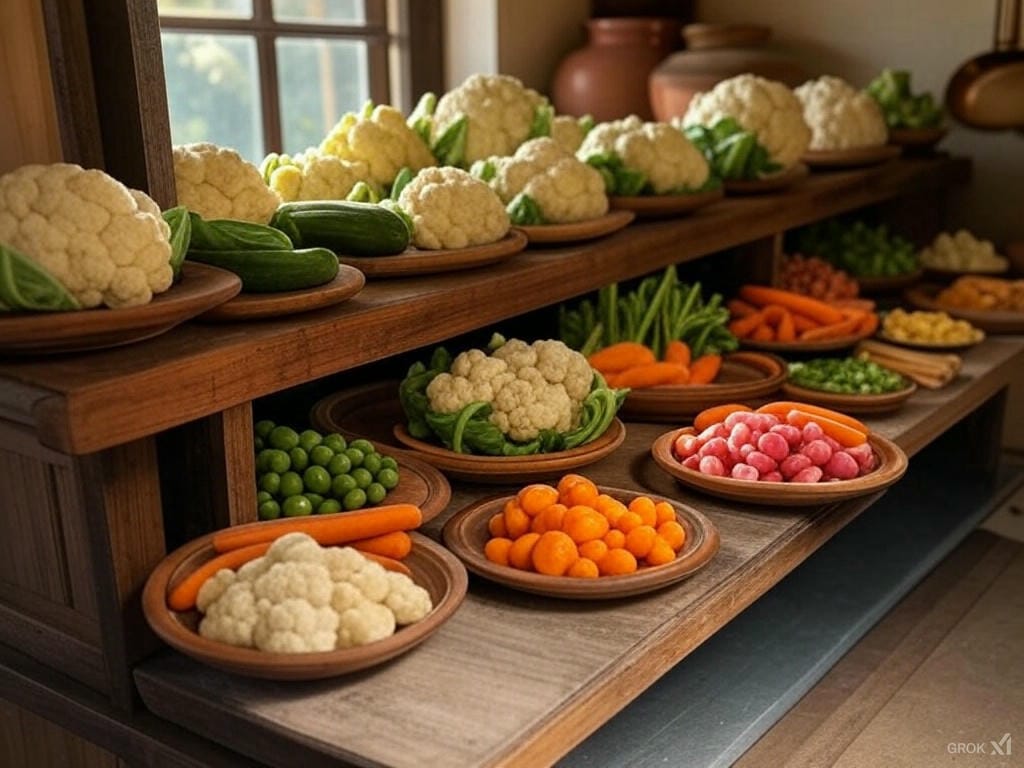
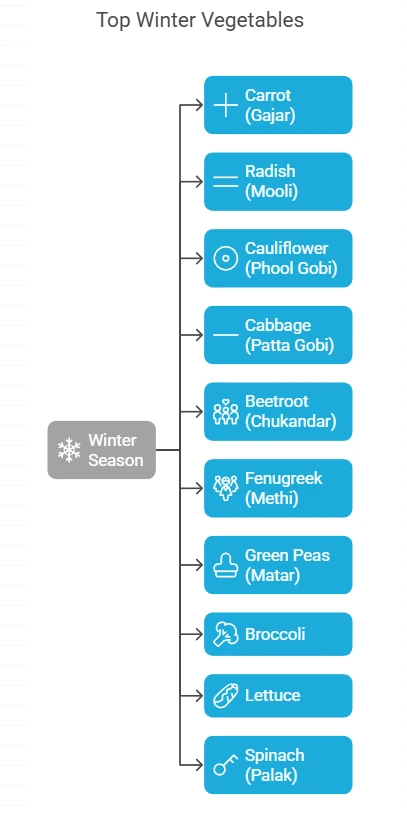
Top 🍂 Monsoon Season vegetables
After the top summer Season vegetables in India, here are the top monsoon season vegetables…
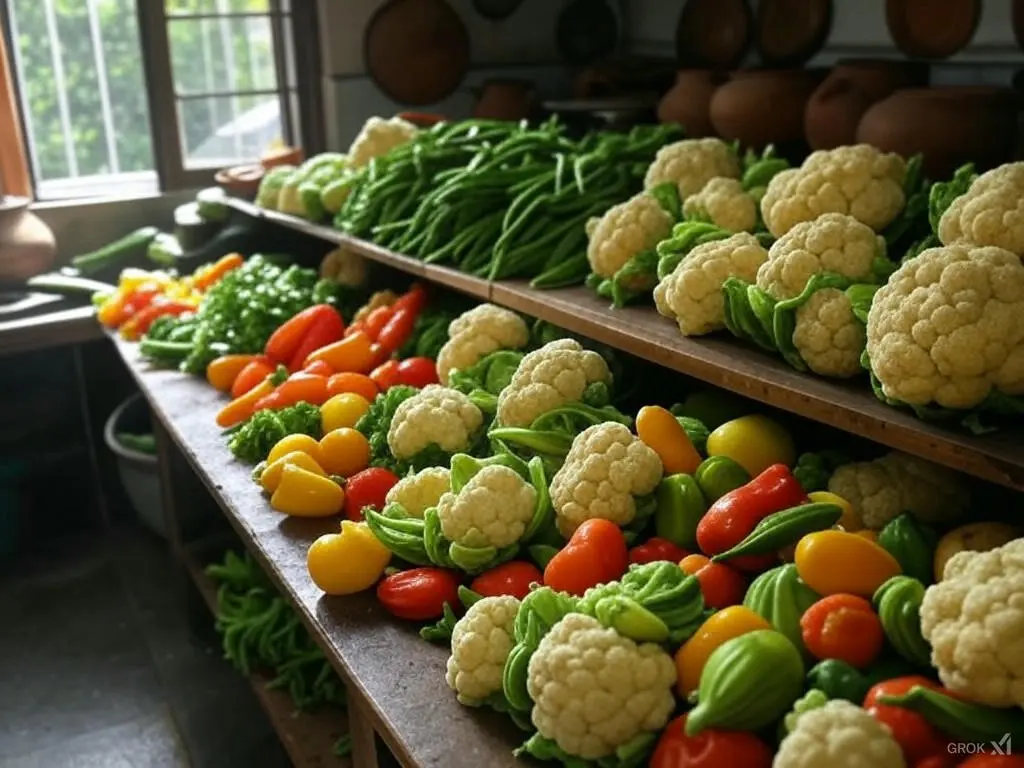
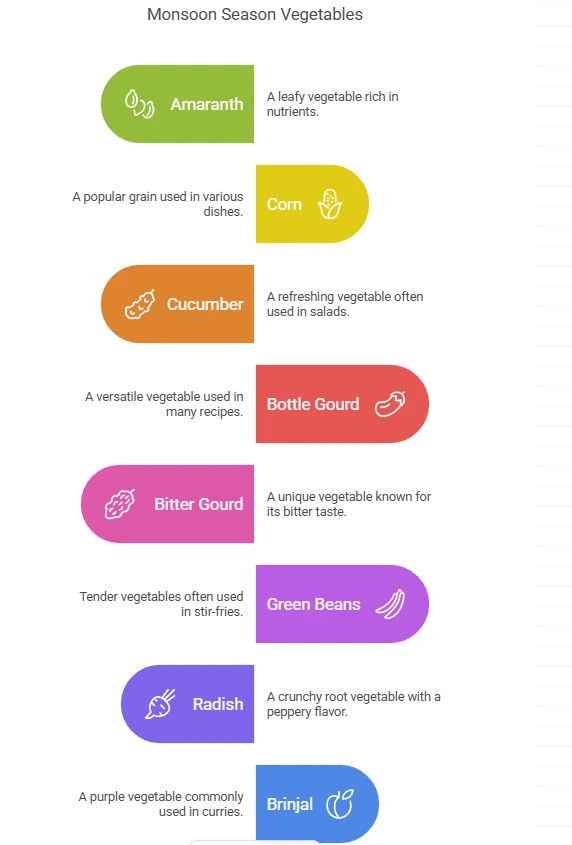
People also ask about summer season vegetables in India some questions
Cucumber: Refreshing and hydrating, cucumbers are ideal for the hot climate.
Brinjal (Eggplant): A versatile vegetable that flourishes in warm temperatures.
Bottle Gourd: Known for its high water content, it helps in staying hydrated.
Okra (Lady’s Finger): A popular summer crop that’s both nutritious and easy to grow.
Pumpkin: Thrives in the heat and can be stored for extended periods.
Cucumber: Sow seeds from March to July.
Brinjal: Best planted between February and April.
Bottle Gourd: Sow seeds from January to March.
Okra: Plant between January and February or from February to March.
Pumpkin: Sow seeds from January to March.
Watering: Water plants early in the morning or late in the evening to minimize evaporation.
Soil Preparation: Use well-draining soil enriched with organic matter.
Mulching: Apply mulch to retain soil moisture and regulate temperature.
Pest Control: Regularly inspect plants for pests and use organic remedies when necessary.
Sunlight: Ensure plants receive adequate sunlight, typically 6-8 hours daily.
Yes, many summer vegetables can be successfully grown in containers:
Cucumber: Use a deep container with a trellis for support.
Brinjal: A medium-sized pot with good drainage works well.
Okra: Grows effectively in deep pots.
Tomatoes: Cherry tomato varieties are particularly suited for containers.
Aphids: Small insects that suck sap from plants. Control them by spraying a mixture of water and mild soap.
Powdery Mildew: A fungal disease causing white powdery spots. Prevent it by ensuring proper air circulation and avoiding overhead watering.
Fruit Borers: Insects that bore into fruits. Handpick and destroy affected fruits and use neem oil sprays as a preventive measure.
Conclusion: Ready to Embrace Summer Veggies?
So, there you have it—a complete guide to summer-season vegetables in India. Whether you’re picking them up fresh from the market or growing them in your backyard, these veggies are your ultimate allies for staying cool, hydrated, and healthy during the scorching summer months.
From the crisp crunch of cucumbers to the comforting taste of bottle gourd, each vegetable brings its unique benefits to the table. And the best part? They’re versatile, delicious, and incredibly easy to incorporate into your daily meals.
Ready to give it a try? Start small—add a refreshing cucumber salad to your lunch or whip up a light bottle of gourd curry for dinner. Trust me, your body will thank you for the extra hydration and nutrients.
Let’s make this summer the healthiest one yet. Which summer vegetable are you excited to try or grow? Share your favourite recipes or gardening tips in the comments below. I’d love to hear from you!
Happy eating, and here’s to a fresh, vibrant summer! 🌞🌱
References:
NABARD (2025). Potential Linked Credit Plan Year: 2025-26. Retrieved from https://www.nabard.org/auth/writereaddata/tender/pub_0201250443531293.pdf
APEDA (2024). Study of Indian Organic Market and Export Promotion Strategy. Retrieved from https://apeda.gov.in/sites/default/files/study_reports/Report_Indian_Organic_Market_and_Export_Promotion_Strategy.pdf
NABARD (2025). NABARD’s Data-Driven Push for Climate-Smart Farming. Retrieved from https://www.nabard.org/news.aspx?cid=552&id=25
Ministry of Commerce and Industry (2024). Annual Report. Retrieved from https://www.commerce.gov.in/wp-content/uploads/2024/12/Annual-Report-English-Lower-Resolution-1.pdf
Government of India (2025). Expenditure Budget 2025-2026. Retrieved from https://www.indiabudget.gov.in/doc/eb/allsbe.pdf
read latest post
ICAR JRF Agronomy: Decoding the 2024-2025 Papers & Cracking the IARI Code
ICAR JRF Agronomy 2 year paper analysis A high ICAR...
Read More100+ Manure, Fertilizer, and Soil Fertility Management MCQ with important one-liners, true/false & fill-in-the-blanks
Author–Kumesh choudhari Table of Contents Hey Agri-dost! Exam season is...
Read More


I’m gone to convey my litle brother, that he should also pay a visit this website
on regular basis to obtain updated from most recent
gossip. https://Bandurart.com/
Hi, its pleasant piece of writing on the topic of media print, we all understand medeia is a enormous source of facts. https://yourua.info/
It’s great that focuses on security and integrity in agriculture industries.
creates cheerful environments that brighten normal days.
I know this website offers quality depending posts and extra data, is there any
other website that presents these kinds of data in quality?